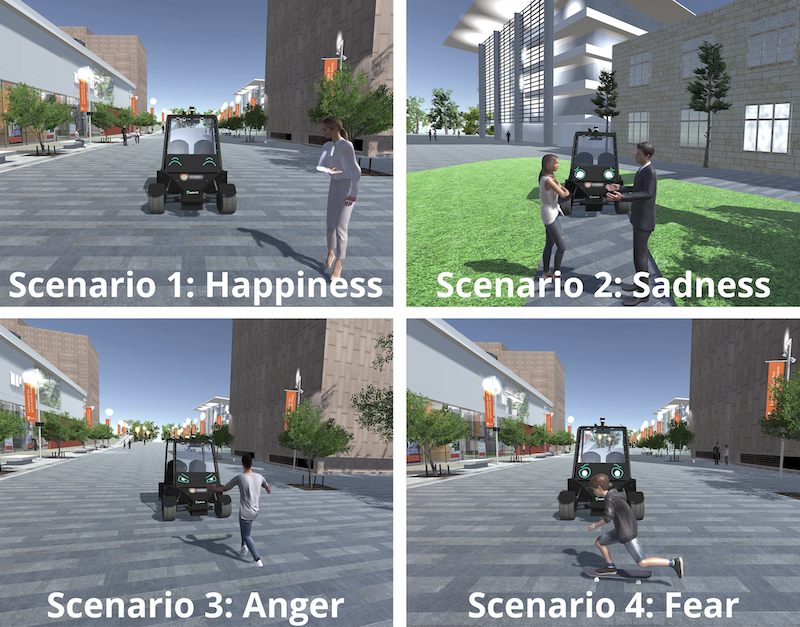Australia is seen as a leader in the development and adoption of driverless cars. Australia’s Smart Cities Plan, highlights that their transformational impact will “fundamentally change how we live and work”. Driverless cars and other autonomous vehicles (AVs) have the potential to contribute to the strategic goals of Australian cities, addressing sustainability and liveability through shared ownership models and reduced congestion.
However, the uptake of autonomous mobility systems relies upon public trust. Recent injuries, and even a fatality, have highlighted the risks they pose to pedestrians in particular. The project investigates new interfaces for improving public trust and pedestrian safety by allowing vehicles to communicate with the people around them. Along the way, it develops a validated approach, referred to as “hyperreal prototyping”, for simulating real interactions with autonomous vehicles in a virtual-reality environment.
Benefits include strategies for making driverless cars safer for pedestrians and a new approach for testing solutions to this emerging problem in a low-cost, low-risk way. The project is funded through the Australian Research Council (ARC) Discovery Project (DP) scheme under the number DP200102604. It involves a collaboration between the University of Sydney’s Design Lab, Urbanism, Intelligent Transport Systems Group (part of the Australian Centre for Field Robotics) and the Media Informatics and Human-Computer Interaction Groups at Ludwig-Maximilian University Munich.
Investigators:
- Martin Tomitsch
- Luke Hespanhol
- Stewart Worrall
- Eduardo Nebot
- Jennifer Kent
- Alexander Wiethoff
- Adrian Ellison
Postdoctoral researcher:
PhD researchers:
- Tram Tran
- Yiyuan Wang
Publications:
- Hoggenmueller, M., Tomitsch, M., and Worrall, S. Designing Interactions With Shared AVs in Complex Urban Mobility Scenarios. Front. Comput. Sci.
- Tran, T. T. M. , Parker, C., Wang, Y., and Tomitsch, M. Designing Wearable Augmented Reality Concepts to Support Scalability in Autonomous Vehicle-Pedestrian Interaction. Front. Comput. Sci.
- Hollaender, K., Hoggenmueller, M., Gruber, R., Völkel, S.T., Butz, A. Take It to The Curb: Scalable Communication Between Autonomous Cars and Vulnerable Road Users Through Curbstone Displays. Front. Comput. Sci.
- Wang, Y., Hespanhol, L., and Tomitsch, M. How Can Autonomous Vehicles Convey Emotions to Pedestrians? A Review of Emotionally Expressive Non-Humanoid Robots. Multimodal Technol. Interact. 2021, 5, 84.
- Tran, T. T. M. , Parker, C., and Tomitsch, M. A Review of Virtual Reality Studies on Autonomous Vehicle–Pedestrian Interaction, in IEEE Transactions on Human-Machine Systems, vol. 51, no. 6, pp. 641-652, Dec. 2021.
- Hoggenmueller, M., Tomitsch, M., Hespanhol, L., Tran, T., Worrall, S. and Nebot, E. (2021). Context-Based Interface Prototyping: Understanding the Effect of Prototype Representation on User Feedback. Proceedings of the ACM CHI Conference on Human Factors in Computing Systems (CHI ’21), ACM.
- Wiethoff, A., Hoggenmueller, M., Rossmy, B. Hirsch, L., Hespanhol, L., Tomitsch, M. (2021). A Media Architecture Approach for Designing the Next Generation of Urban Interfaces. Journal of Interaction Design and Architecture(s) Journal (IxD&A), N.48, pp. 9-32.
- Tomitsch, M., Hoggenmueller, M. (2021). Designing Human–Machine Interactions in the Automated City: Methodologies, Considerations, Principles. In: Wang B.T., Wang C.M. (eds), Automating Cities: Design, Construction, Operation and Future Impact (Advances in 21st Century Human Settlements), Springer, Singapore.
- Hoggenmueller, M., Tomitsch, M., Parker, C., Nguyen, T., Zhou, D. and Worrall, S. (2020). A Tangible Multi-Display Toolkit to Support the Collaborative Design Exploration of AV-Pedestrian Interfaces. Proceedings of the 32nd Australian Conference on Human-Computer-Interaction (OzCHI’20), ACM.
Studies
-

Affective Autonomous Vehicle-Pedestrian Interaction
This project aims to enhance the perceived sociability, perceived safety, and user experience of autonomous…
-

Evaluating Interactions With Autonomous Vehicles in VR
This project investigates which simulation platforms and prototyping representations to use for evaluating interactions between…
-

Collaborative Design Exploration of AV-Pedestrian Interfaces
We developed a tangible multi-display toolkit to support collaborative design explorations of AV-pedestrian interfaces.